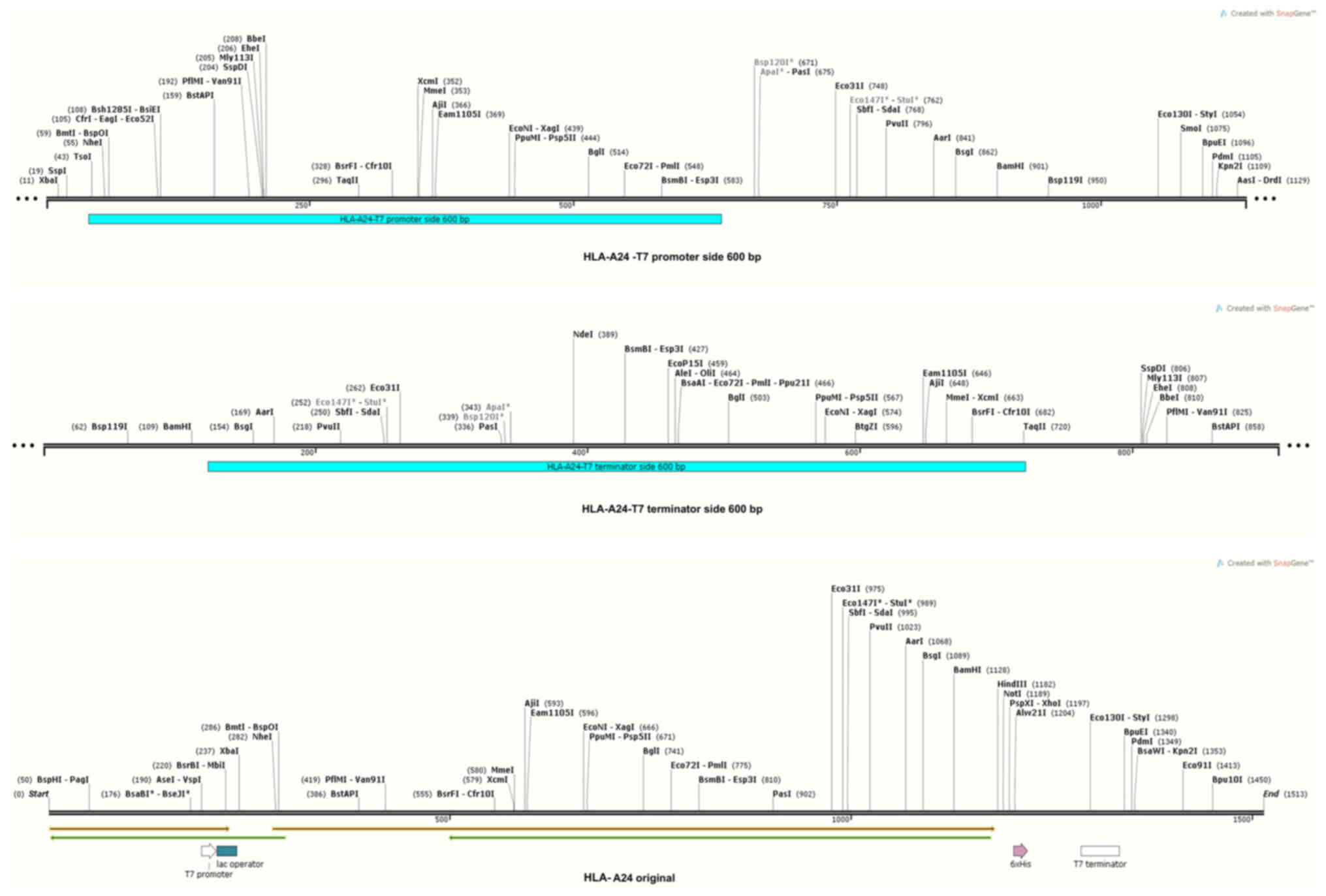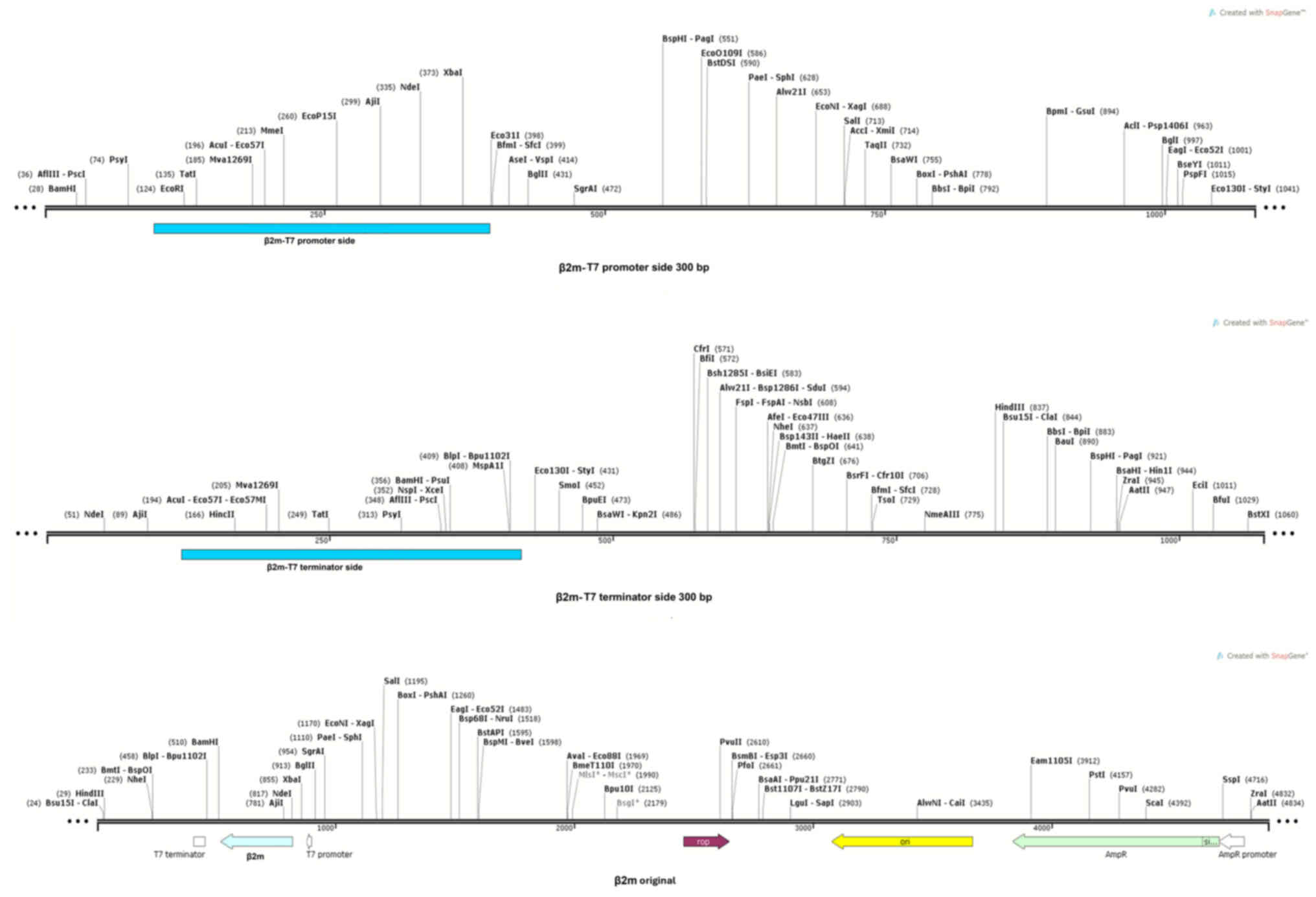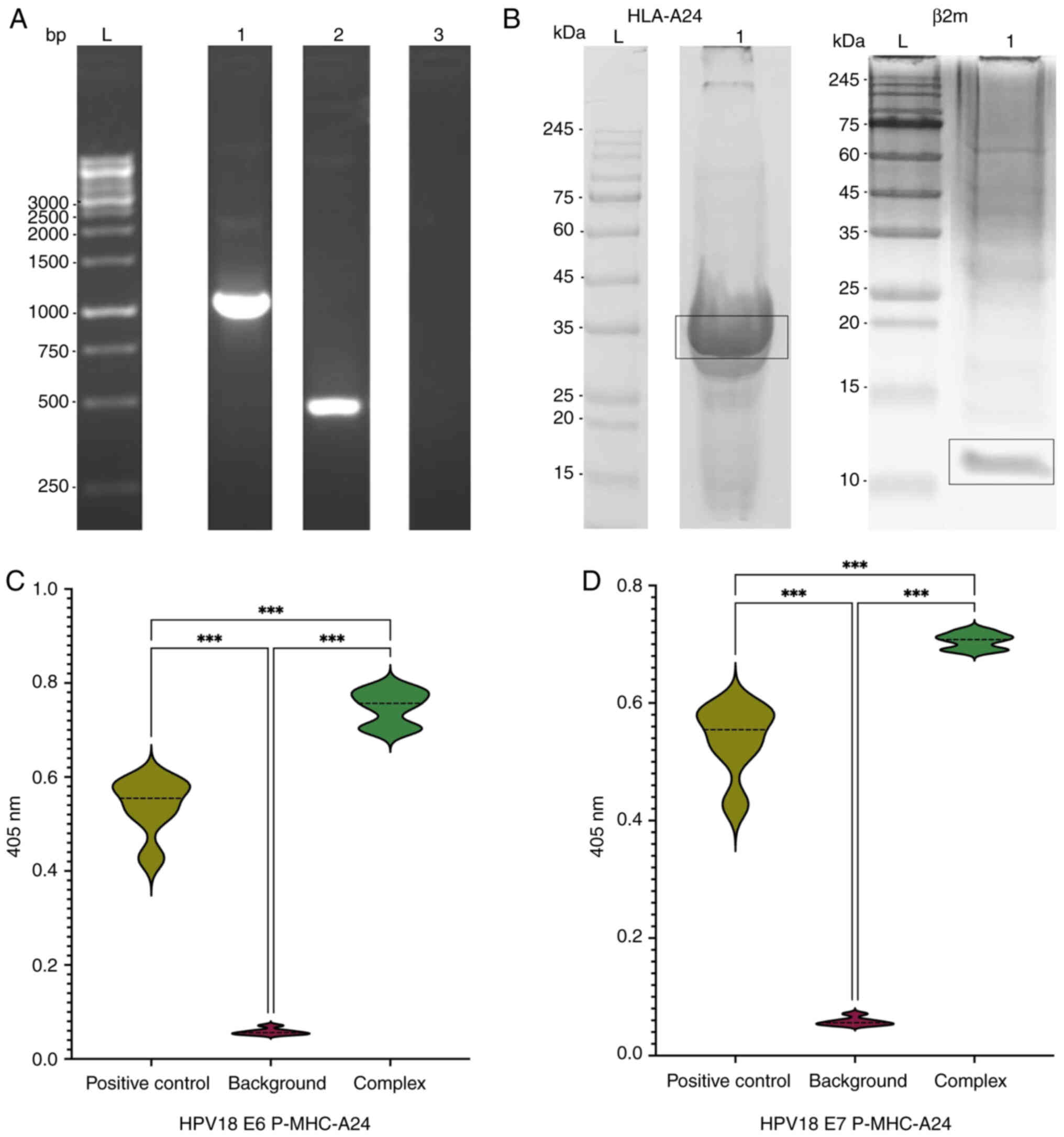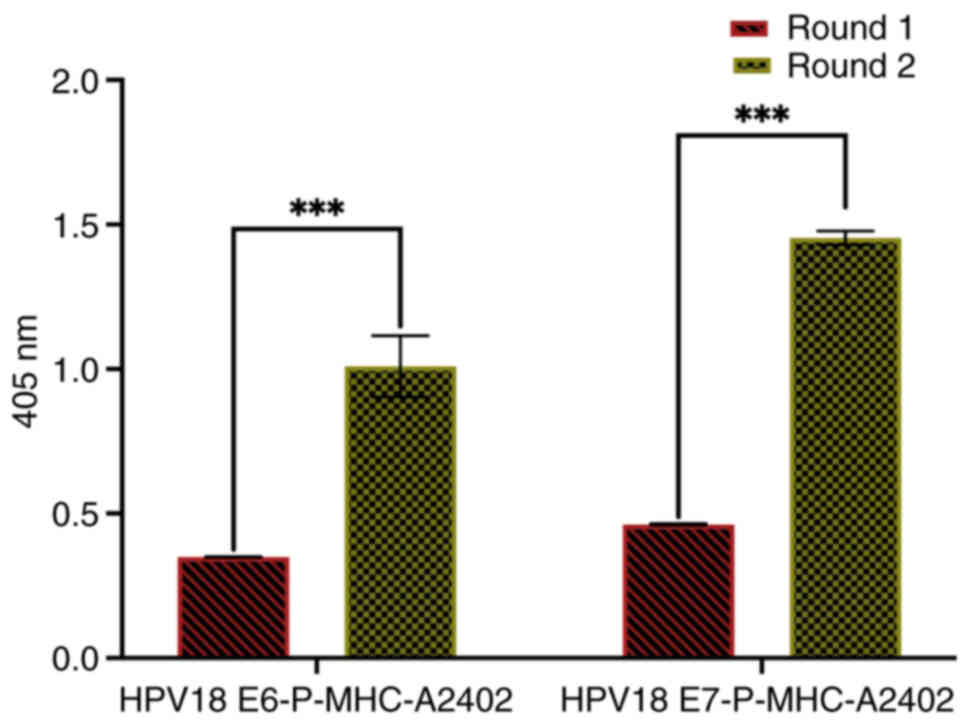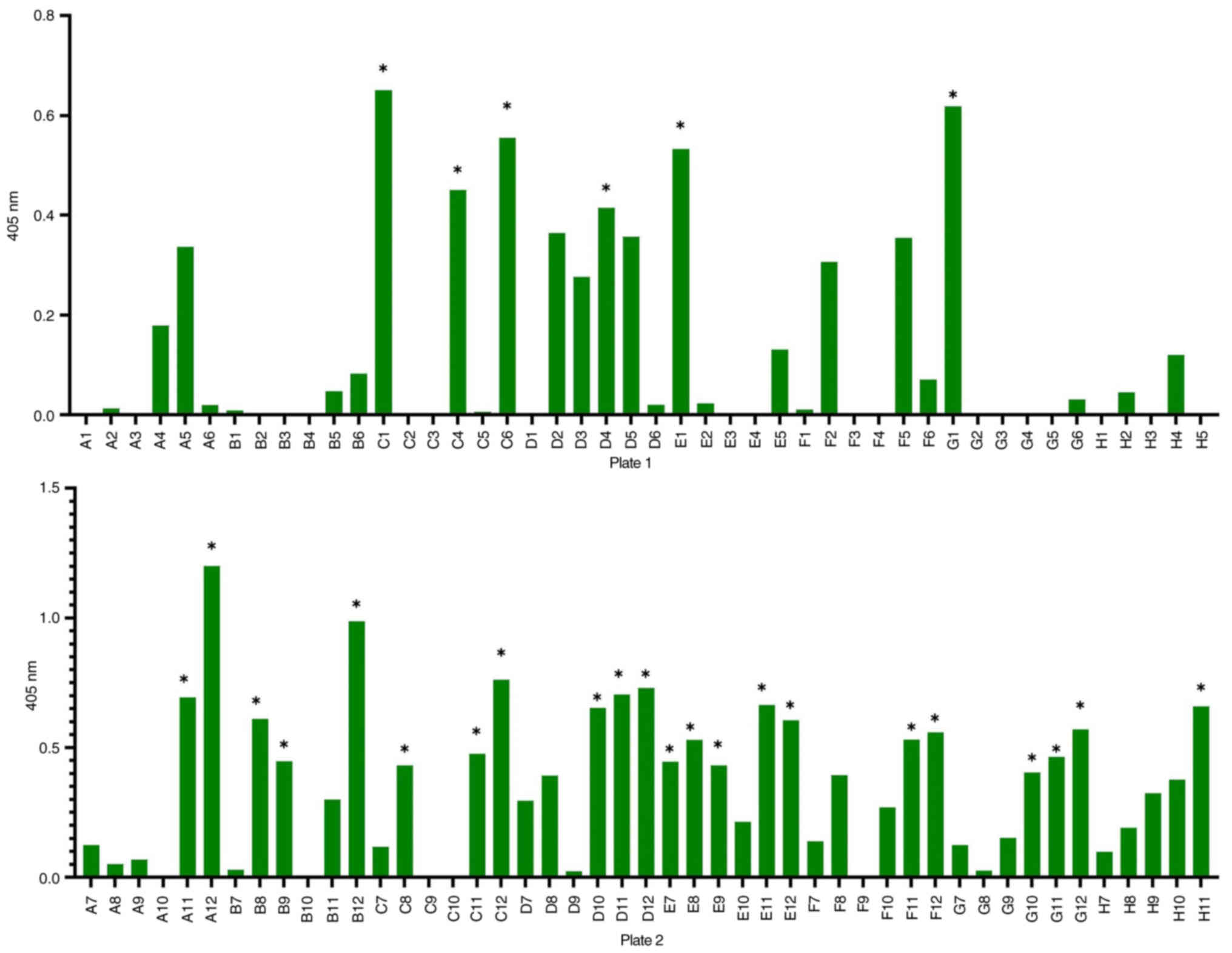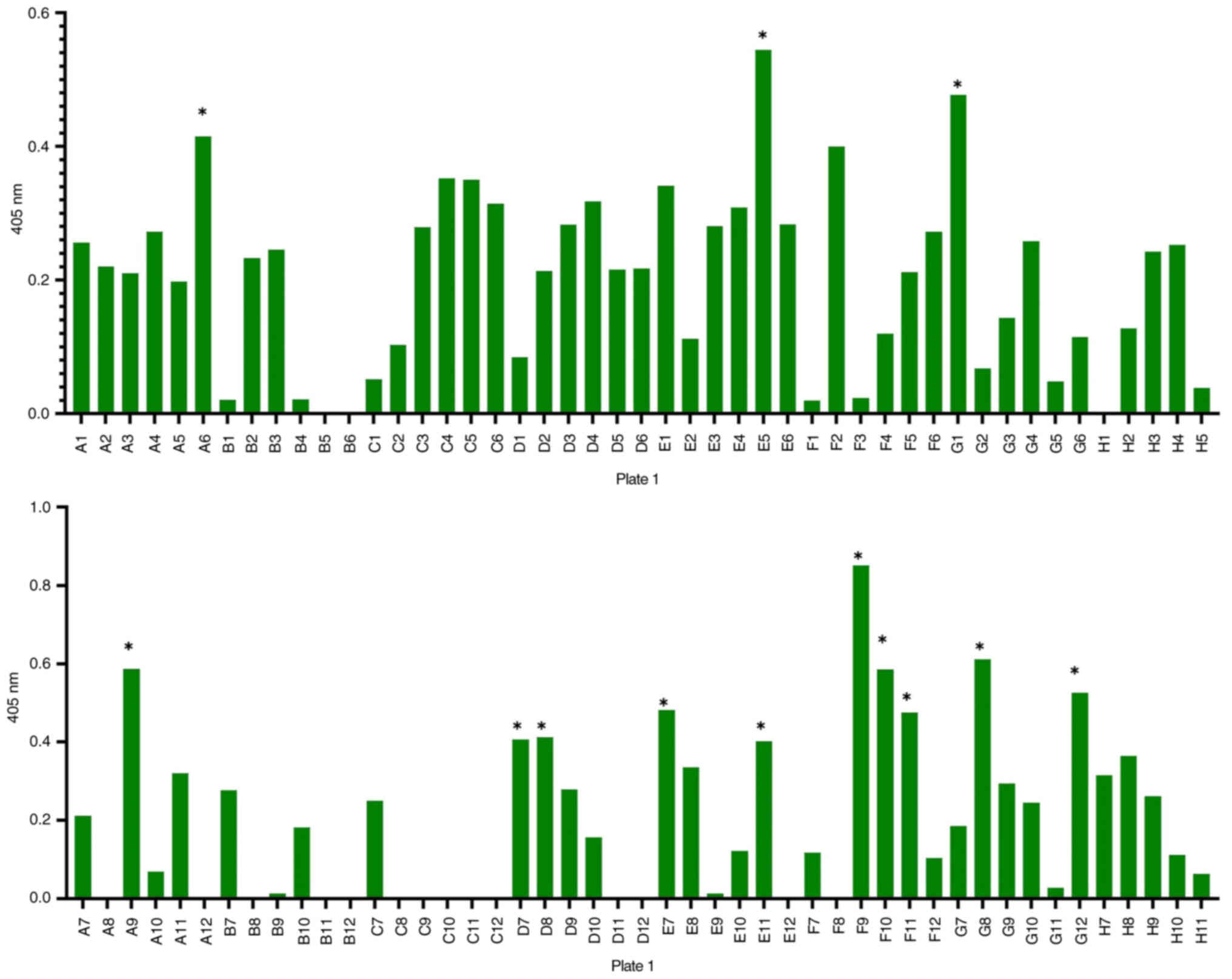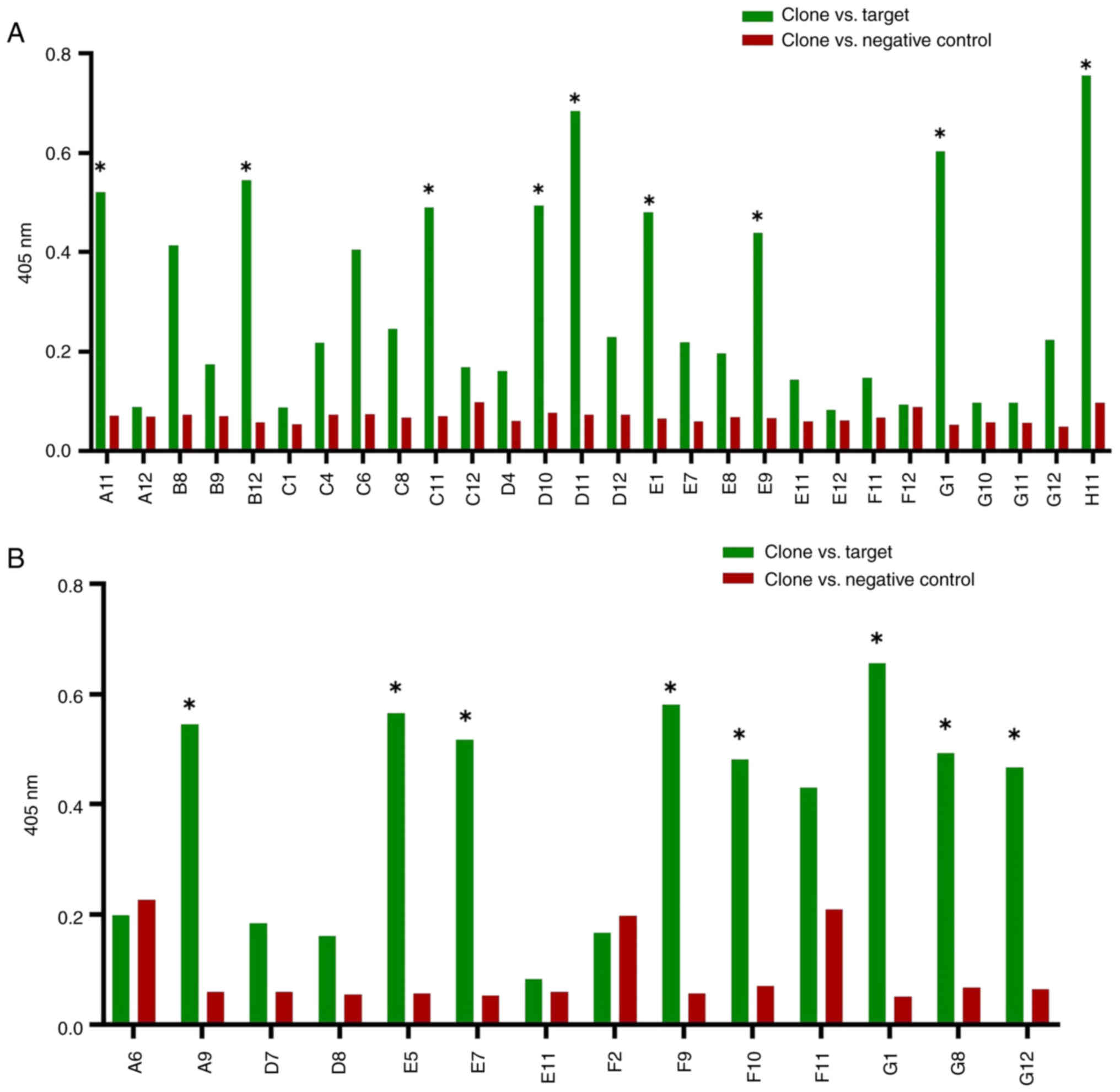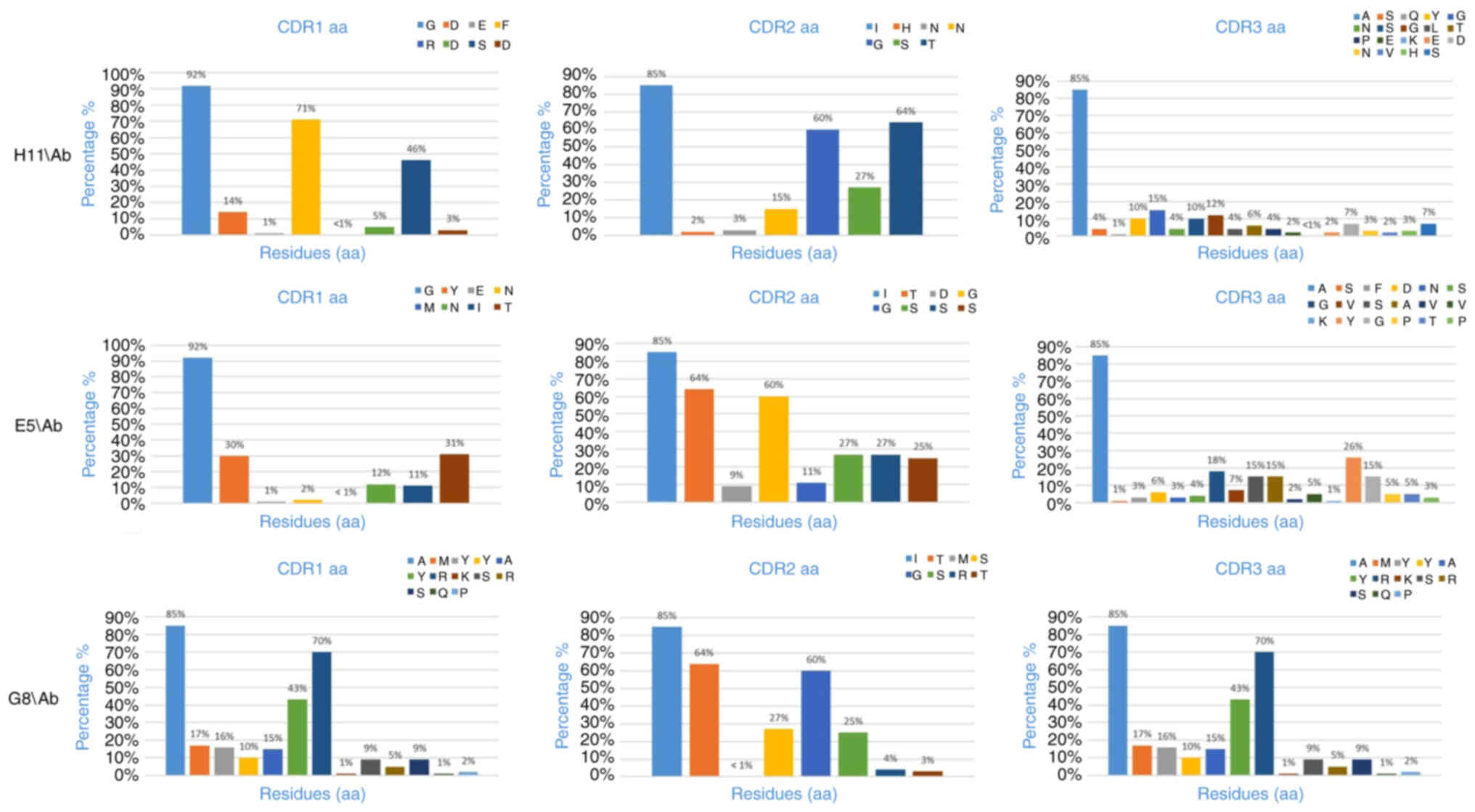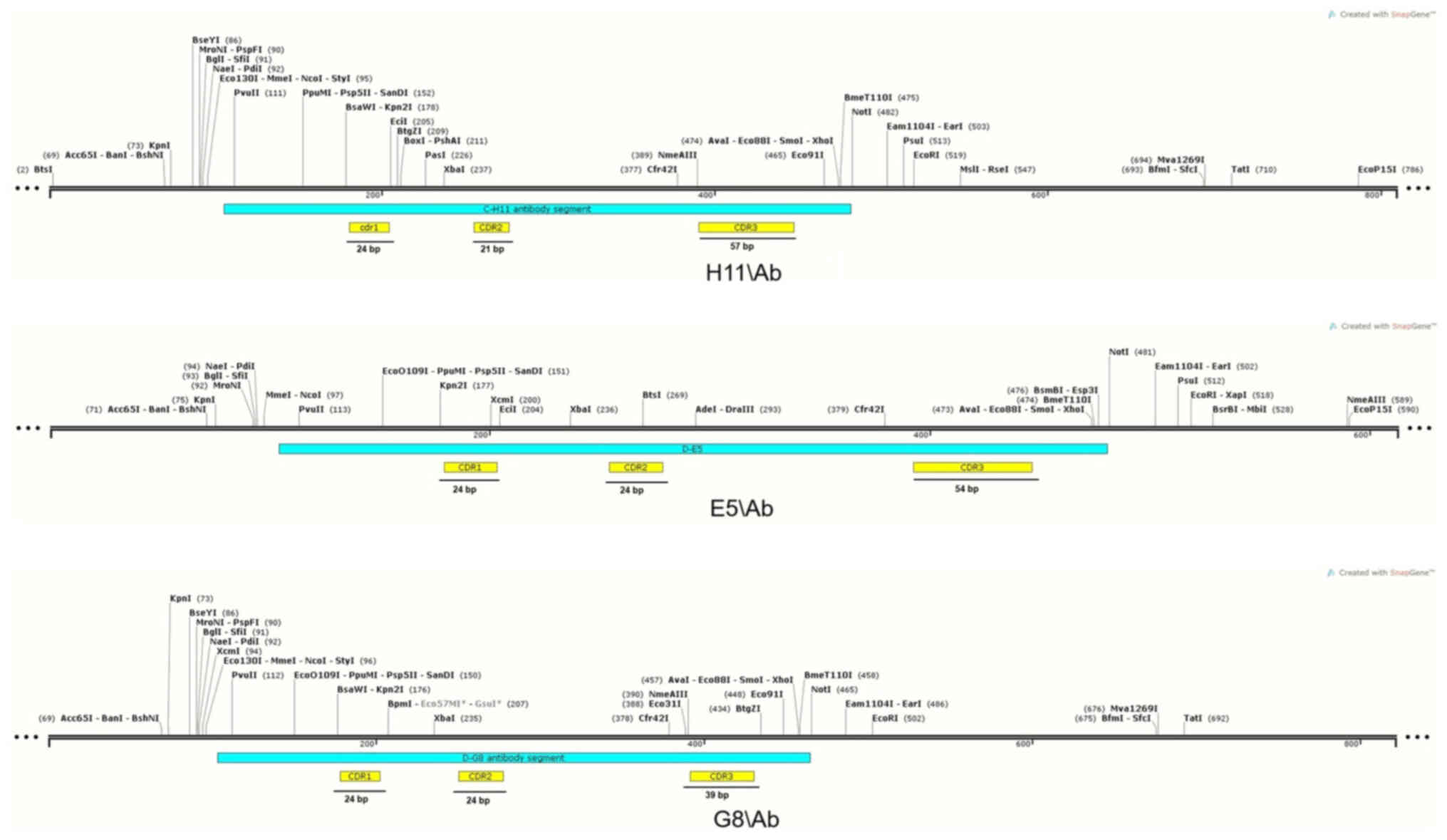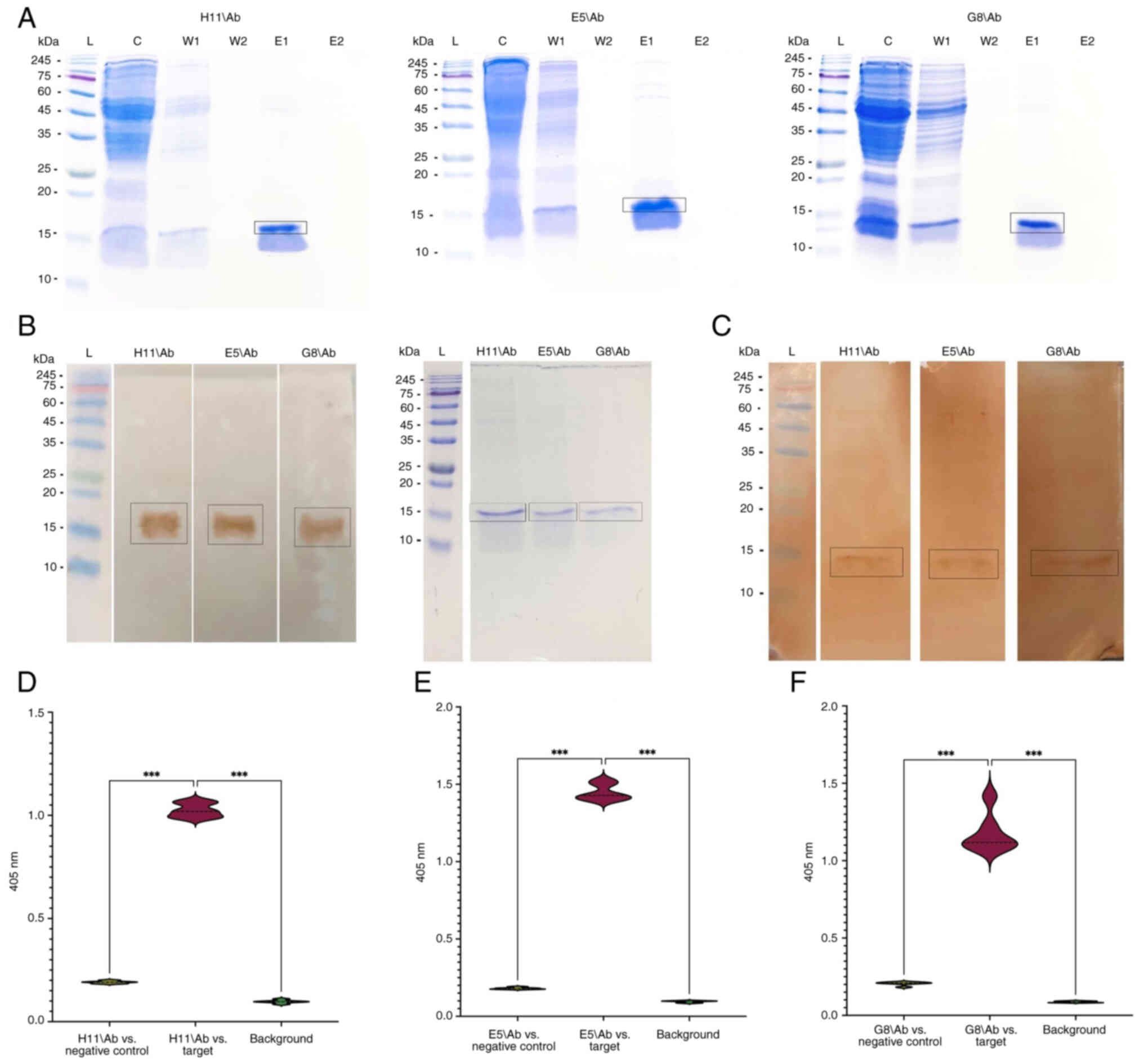|
1
|
World Health Organization (WHO), . Global
strategy to accelerate the elimination of cervical cancer as a
public health problem. WHO; Geneva: 2020
|
|
2
|
Wang M, Huang K, Wong MCS, Huang J, Jin Y
and Zheng ZJ: Global cervical cancer incidence by histological
subtype and implications for screening methods. J Epidemiol Glob
Health. 14:94–101. 2024. View Article : Google Scholar : PubMed/NCBI
|
|
3
|
de Sanjose S, Quint WG, Alemany L, Geraets
DT, Klaustermeier JE, Lloveras B, Tous S, Felix A, Bravo LE, Shin
HR, et al: Human papillomavirus genotype attribution in invasive
cervical cancer: A retrospective cross-sectional worldwide study.
Lancet Oncol. 11:1048–1056. 2010. View Article : Google Scholar : PubMed/NCBI
|
|
4
|
Boni SP, Tenet V, Horo A, Heideman DAM,
Bleeker MCG, Tanon A, Mian B, Mohenou ID, Ekouevi DK, Gheit T, et
al: High-risk human papillomavirus distribution according to human
immunodeficiency virus status among women with cervical cancer in
Abidjan, Côte d'Ivoire, 2018 to 2020. Int J Cancer. 154:962–968.
2024. View Article : Google Scholar : PubMed/NCBI
|
|
5
|
Zhang L, Li M, Yuan F, Jiang J and Zhang
X: The difference of transcriptome of HPV-infected patients
contributes more to the occurrence of cervical cancer than the
mutations of E6 and E7 genes in HPV16. Medicine (Baltimore).
103:e368222024. View Article : Google Scholar : PubMed/NCBI
|
|
6
|
Jabbar SF, Abrams L, Glick A and Lambert
PF: Persistence of high-grade cervical dysplasia and cervical
cancer requires the continuous expression of the human
papillomavirus type 16 E7 oncogene. Cancer Res. 69:4407–4414. 2009.
View Article : Google Scholar : PubMed/NCBI
|
|
7
|
Pflaum J, Schlosser S and Müller M: p53
family and cellular stress responses in cancer. Front Oncol.
4:2852014. View Article : Google Scholar : PubMed/NCBI
|
|
8
|
Boyer SN, Wazer DE and Band V: E7 protein
of human papilloma virus-16 induces degradation of retinoblastoma
protein through the ubiquitin-proteasome pathway. Cancer Res.
56:4620–4624. 1996.PubMed/NCBI
|
|
9
|
Bahmani B, Amini-Bayat Z, Ranjbar MM,
Bakhtiari N and Zarnani AH: HPV16-E7 protein T cell epitope
prediction and global therapeutic peptide vaccine design based on
human leukocyte antigen frequency: An in-silico study. Int J Pept
Res Ther. 27:365–378. 2021. View Article : Google Scholar : PubMed/NCBI
|
|
10
|
Koliopoulos G, Nyaga VN, Santesso N,
Bryant A, Martin-Hirsch PP, Mustafa RA, Schünemann H, Paraskevaidis
E and Arbyn M: Cytology versus HPV testing for cervical cancer
screening in the general population. Cochrane Database Syst Rev.
8:CD0085872017.PubMed/NCBI
|
|
11
|
Cortés-Alaguero C, González-Mirasol E,
Morales-Roselló J and Poblet-Martinez E: Do clinical data and human
papilloma virus genotype influence spontaneous regression in grade
I cervical intraepithelial neoplasia? J Turk Ger Gynecol Assoc.
18:1–8. 2017. View Article : Google Scholar : PubMed/NCBI
|
|
12
|
Sroczynski G, Esteban E, Widschwendter A,
Oberaigner W, Borena W, von Laer D, Hackl M, Endel G and Siebert U:
Reducing overtreatment associated with overdiagnosis in cervical
cancer screening-A model-based benefit-harm analysis for Austria.
Int J Cancer. 147:1131–1142. 2020. View Article : Google Scholar : PubMed/NCBI
|
|
13
|
Peng S, Xing D, Ferrall L, Tsai YC, Hung
CF and Wu TC: Identification of human MHC-I HPV18 E6/E7-specific
CD8 + T cell epitopes and generation of an HPV18 E6/E7-expressing
adenosquamous carcinoma in HLA-A2 transgenic mice. J Biomed Sci.
29:802022. View Article : Google Scholar : PubMed/NCBI
|
|
14
|
Middleton D, Menchaca L, Rood H and
Komerofsky R: New allele frequency database. http://www.allelefrequencies.netTissue Antigens.
61:403–407. 2003. View Article : Google Scholar : PubMed/NCBI
|
|
15
|
Sanchez-Mazas A and Nunes JM: PGAE HLA
Consortium of the 18th International HLA and Immunogenetics
Workshop: The most frequent HLA alleles around the world: A
fundamental synopsis. Best Pract Res Clin Haematol. 37:1015592024.
View Article : Google Scholar : PubMed/NCBI
|
|
16
|
Arrieta-Bolaños E, Hernández-Zaragoza DI
and Barquera R: An HLA map of the world: A comparison of HLA
frequencies in 200 worldwide populations reveals diverse patterns
for class I and class II. Front Genet. 14:8664072023. View Article : Google Scholar : PubMed/NCBI
|
|
17
|
Ferrera A, Valladares W, Cabrera Y, de la
Luz Hernandez M, Darragh T, Baena A, Almonte M and Herrero R:
Performance of an HPV 16/18 E6 oncoprotein test for detection of
cervical precancer and cancer. Int J Cancer. 145:2042–2050. 2019.
View Article : Google Scholar : PubMed/NCBI
|
|
18
|
Nagano K and Tsutsumi Y: Phage display
technology as a powerful platform for antibody drug discovery.
Viruses. 13:1782021. View Article : Google Scholar : PubMed/NCBI
|
|
19
|
Hammers CM and Stanley JR: Antibody phage
display: Technique and applications. J Invest Dermatol. 134:1–5.
2014. View Article : Google Scholar : PubMed/NCBI
|
|
20
|
Cohen M and Reiter Y: T-cell receptor-like
antibodies: Targeting the intracellular proteome therapeutic
potential and clinical applications. Antibodies. 2:517–534. 2013.
View Article : Google Scholar
|
|
21
|
Andersen PS, Stryhn A, Hansen BE, Fugger
L, Engberg J and Buus S: A recombinant antibody with the
antigen-specific, major histocompatibility complex-restricted
specificity of T cells. Proc Natl Acad Sci USA. 93:1820–1824. 1996.
View Article : Google Scholar : PubMed/NCBI
|
|
22
|
Altman JD, Moss PA, Goulder PJ, Barouch
DH, McHeyzer-Williams MG, Bell JI, McMichael AJ and Davis MM:
Phenotypic analysis of antigen-specific T lymphocytes. Science.
274:94–96. 1996. View Article : Google Scholar : PubMed/NCBI
|
|
23
|
Garboczi DN, Hung DT and Wiley DC:
HLA-A2-peptide complexes: Refolding and crystallization of
molecules expressed in Escherichia coli and complexed with
single antigenic peptides. Proc Natl Acad Sci USA. 89:3429–3433.
1992. View Article : Google Scholar : PubMed/NCBI
|
|
24
|
Denkberg G, Cohen CJ and Reiter Y:
Critical role for CD8 in binding of MHC tetramers to TCR: CD8
antibodies block specific binding of human tumor-specific
MHC-peptide tetramers to TCR. J Immunol. 167:270–276. 2001.
View Article : Google Scholar : PubMed/NCBI
|
|
25
|
Yazdani Z, Rafiei A, Valadan R, Ashrafi H,
Pasandi M and Kardan M: Designing a potent L1 protein-based HPV
peptide vaccine: A bioinformatics approach. Comput Biol Chem.
85:1072092020. View Article : Google Scholar : PubMed/NCBI
|
|
26
|
Rammensee H, Bachmann J, Emmerich NP,
Bachor OA and Stevanović S SYFPEITHI: Database for MHC ligands and
peptide motifs. Immunogenetics. 50:213–219. 1999. View Article : Google Scholar : PubMed/NCBI
|
|
27
|
Chang AY, Chau V, Landas JA and Pang Y:
Preparation of calcium competent Escherichia coli and
heat-shock transformation. JEMI Methods. 1:22–25. 2017.
|
|
28
|
McConkey VL: DNA-barcoding for the
inference of larval community structure of non-biting midges
(Chironomidae) from the River Stour, Kent (unpublished thesis).
Canterbury Christ Church University; 2017
|
|
29
|
Figueroa-Bossi N, Balbontín R and Bossi L:
Preparing plasmid DNA from bacteria. Cold Spring Harb Protoc.
2022.Pdb.prot107852. 2022. View Article : Google Scholar
|
|
30
|
Rodenko B, Toebes M, Hadrup SR, Van Esch
WJE, Molenaar AM, Schumacher TNM and Ovaa H: Generation of
peptide-MHC class I complexes through UV-mediated ligand exchange.
Nat Protoc. 1:1120–1132. 2006. View Article : Google Scholar : PubMed/NCBI
|
|
31
|
Manns JM: SDS-polyacrylamide gel
electrophoresis (SDS-PAGE) of proteins. Curr Protoc Microbiol.
22:A.3M.1–A.3M.13. 2011.
|
|
32
|
Luimstra JJ, Franken KMCL, Garstka MA,
Drijfhout JW, Neefjes J and Ovaa H: Production and thermal exchange
of conditional peptide-MHC I multimers. Curr Protoc Immunol.
126:e852019. View Article : Google Scholar : PubMed/NCBI
|
|
33
|
Lee CMY, Iorno N, Sierro F and Christ D:
Selection of human antibody fragments by phage display. Nat Protoc.
2:3001–3008. 2007. View Article : Google Scholar : PubMed/NCBI
|
|
34
|
Dass SA, Norazmi MN, Dominguez AA, San
Miguel MESG and Tye GJ: Generation of a T cell receptor (TCR)-like
single domain antibody (sDAb) against a mycobacterium tuberculosis
(Mtb) heat shock protein (HSP) 16kDa antigen presented by Human
Leukocyte Antigen (HLA)-A*02. Mol Immunol. 101:189–196. 2018.
View Article : Google Scholar : PubMed/NCBI
|
|
35
|
Dass SA, Norazmi MN, Acosta A, Sarmiento
ME and Tye GJ: TCR-like domain antibody against mycobacterium
tuberculosis (Mtb) heat shock protein antigen presented by HLA-A*11
and HLA-A*24. Int J Biol Macromol. 155:305–314. 2020. View Article : Google Scholar : PubMed/NCBI
|
|
36
|
Falgenhauer E, von Schönberg S, Meng C,
Mückl A, Vogele K, Emslander Q, Ludwig C and Simmel FC: Evaluation
of an E. coli cell extract prepared by lysozyme-assisted
sonication via gene expression, phage assembly and proteomics.
Chembiochem. 22:2805–2813. 2021. View Article : Google Scholar : PubMed/NCBI
|
|
37
|
Rouet R, Lowe D, Dudgeon K, Roome B,
Schofield P, Langley D, Andrews J, Whitfeld P, Jermutus L and
Christ D: Expression of high-affinity human antibody fragments in
bacteria. Nat Protoc. 7:364–373. 2012. View Article : Google Scholar : PubMed/NCBI
|
|
38
|
Zhao WB, Shen Y, Liu WH, Li YM, Jin SJ, Xu
YC, Pan LQ, Zhou Z and Chen SQ: Soluble expression of Fc-fused T
cell receptors allows yielding novel bispecific T cell engagers.
Biomedicines. 9:7902021. View Article : Google Scholar : PubMed/NCBI
|
|
39
|
Dahan R and Reiter Y: T-cell-receptor-like
antibodies-generation, function and applications. Expert Rev Mol
Med. 14:e62012. View Article : Google Scholar : PubMed/NCBI
|
|
40
|
Dass SA, Selva Rajan R, Tye GJ and
Balakrishnan V: The potential applications of T cell receptor
(TCR)-like antibody in cervical cancer immunotherapy. Hum Vaccin
Immunother. 17:2981–2994. 2021. View Article : Google Scholar : PubMed/NCBI
|
|
41
|
Tan LK, Mohd-Farid B, Salsabil S, Heselynn
H, Wahinuddin S, Lau S, Gun SC, Nor-Suhaila S, Eashwary M,
Mohd-Shahrir MS, et al: HLA-A, -B, -C, -DRB1 and -DQB1 alleles and
haplotypes in 951 Southeast Asia Malays from Peninsular Malaysia.
Hum Immunol. 77:818–819. 2016. View Article : Google Scholar : PubMed/NCBI
|
|
42
|
Schuler MM, Nastke MD and Stevanović S:
SYFPEITHI: Database for searching and T-cell epitope prediction.
Immunoinformatics: Predicting immunogenicity in silico. 75–93.
2007. View Article : Google Scholar : PubMed/NCBI
|
|
43
|
Rammensee H, Bachmann J, Emmerich NP,
Bachor OA and Stevanović S: SYFPEITHI: Database for MHC ligands and
peptide motifs. Immunogenetics. 50:213–319. 1999. View Article : Google Scholar : PubMed/NCBI
|
|
44
|
Lim BN, Chin CF, Choong YS, Ismail A and
Lim TS: Generation of a naïve human single chain variable fragment
(scFv) library for the identification of monoclonal scFv against
Salmonella Typhi Hemolysin E antigen. Toxicon. 117:94–101. 2016.
View Article : Google Scholar : PubMed/NCBI
|
|
45
|
Dang E, Yang S, Song C, Jiang D, Li Z, Fan
W, Sun Y, Tao L, Wang J, Liu T, et al: BAP31, a newly defined
cancer/testis antigen, regulates proliferation, migration, and
invasion to promote cervical cancer progression. Cell Death Dis.
9:7912018. View Article : Google Scholar : PubMed/NCBI
|
|
46
|
Cheng J, Zhao L, Zhang Y, Qin Y, Guan Y,
Zhang T, Liu C and Zhou J: Understanding the mechanisms of
resistance to CAR T-cell therapy in malignancies. Front Oncol.
9:12372019. View Article : Google Scholar : PubMed/NCBI
|
|
47
|
Dao T, Yan S, Veomett N, Pankov D, Zhou L,
Korontsvit T, Scott A, Whitten J, Maslak P, Casey E, et al:
Targeting the intracellular WT1 oncogene product with a therapeutic
human antibody. Sci Transl Med. 5:176ra332013. View Article : Google Scholar : PubMed/NCBI
|
|
48
|
Chames P, Hufton SE, Coulie PG,
Uchanska-Ziegler B and Hoogenboom HR: Direct selection of a human
antibody fragment directed against the tumor T-cell epitope
HLA-A1-MAGE-A1 from a nonimmunized phage-Fab library. Proc Natl
Acad Sci USA. 97:7969–7974. 2000. View Article : Google Scholar : PubMed/NCBI
|
|
49
|
Neethling FA, Ramakrishna V, Keler T,
Buchli R, Woodburn T and Weidanz JA: Assessing vaccine potency
using TCRmimic antibodies. Vaccine. 26:3092–3102. 2008. View Article : Google Scholar : PubMed/NCBI
|
|
50
|
Li D, Bentley C, Anderson A, Wiblin S,
Cleary KL, Koustoulidou S, Hassanali T, Yates J, Greig J, Nordkamp
MO, et al: Development of a T-cell receptor mimic antibody against
wild-type p53 for cancer immunotherapy. Cancer Res. 77:2699–2711.
2017. View Article : Google Scholar : PubMed/NCBI
|
|
51
|
Weidanz JA, Nguyen T, Woodburn T,
Neethling FA, Chiriva-Internati M, Hildebrand WH and Lustgarten J:
Levels of specific peptide-HLA class I complex predicts tumor cell
susceptibility to CTL killing. J Immunol. 177:5088–5097. 2006.
View Article : Google Scholar : PubMed/NCBI
|
|
52
|
Epel M, Carmi I, Soueid-Baumgarten S, Oh
S, Bera T, Pastan I, Berzofsky J and Reiter Y: Targeting TARP, a
novel breast and prostate tumor-associated antigen, with T cell
receptor-like human recombinant antibodies. Eur J Immunol.
38:1706–1720. 2008. View Article : Google Scholar : PubMed/NCBI
|
|
53
|
Wittman VP, Woodburn D, Nguyen T,
Neethling FA, Wright S and Weidanz JA: Antibody targeting to a
class I MHC-peptide epitope promotes tumor cell death. J Immunol.
177:4187–4195. 2006. View Article : Google Scholar : PubMed/NCBI
|
|
54
|
Cohen CJ, Hoffmann N, Farago M, Hoogenboom
HR, Eisenbach L and Reiter Y: Direct detection and quantitation of
a distinct T-cell epitope derived from tumor-specific epithelial
cell-associated mucin using human recombinant antibodies endowed
with the antigen-specific, major histocompatibility
complex-restricted specificity of T cells. Cancer Res.
62:5835–5844. 2002.PubMed/NCBI
|
|
55
|
Lev A, Denkberg G, Cohen CJ, Tzukerman M,
Skorecki KL, Chames P, Hoogenboom HR and Reiter Y: Isolation and
characterization of human recombinant antibodies endowed with the
antigen-specific, major histocompatibility complex-restricted
specificity of T cells directed toward the widely expressed tumor
T-cell epitopes of the telomerase catalytic subunit. Cancer Res.
62:3184–3194. 2002.PubMed/NCBI
|
|
56
|
Willemsen R, Debets R, Hart E, Hoogenboom
H, Bolhuis R and Chames P: A phage display selected fab fragment
with MHC class I-restricted specificity for MAGE-A1 allows for
retargeting of primary human T lymphocytes. Gene Ther. 8:1601–1608.
2001. View Article : Google Scholar : PubMed/NCBI
|
|
57
|
Chang AY, Dao T, Gejman RS, Jarvis CA,
Scott A, Dubrovsky L, Mathias MD, Korontsvit T, Zakhaleva V, Curcio
M, et al: A therapeutic T cell receptor mimic antibody targets
tumor-associated PRAME peptide/HLA-I antigens. J Clin Invest.
127:2705–2718. 2017. View Article : Google Scholar : PubMed/NCBI
|
|
58
|
Sastry KS, Too CT, Kaur K, Gehring AJ, Low
L, Javiad A, Pollicino T, Li L, Kennedy PT, Lopatin U, et al:
Targeting hepatitis B virus-infected cells with a T-cell
receptor-like antibody. J Virol. 85:1935–1942. 2011. View Article : Google Scholar : PubMed/NCBI
|
|
59
|
Desai I, Thakur S and Pagariya P: Current
advances in immunotherapy for cancer. Oral Oncol Rep.
12:1006522024. View Article : Google Scholar
|
|
60
|
Zhao Y, Zhang L, Fang W, Yang Y, Huang Y,
Zou W, Wang Z, Ding M, Peng Y, Xiao S, et al: SI-B001 plus
chemotherapy in patients with locally advanced or metastatic
EGFR/ALK wild-type non-small cell lung cancer: A phase II,
multicenter, open-label study. J Clin Oncol. 41 (16
Suppl):S90252023. View Article : Google Scholar
|
|
61
|
Yang Y, Zhao Y, Zhou T, Chen G, Huang Y,
Liu F, Liu Z, Qu S, Lei Y, Chen X, et al: A phase Ib study of
SHR-1701, a bifunctional fusion protein targeting PD-L1 and TGF-β,
in patients with recurrent or metastatic nasopharyngeal carcinoma
(RM-NPC). J Clin Oncol. 40 (16 Suppl):S60242022. View Article : Google Scholar
|
|
62
|
Lesokhin AM, Tomasson MH, Arnulf B, Bahlis
NJ, Miles Prince H, Niesvizky R, Rodrίguez-Otero P, Martinez-Lopez
J, Koehne G, Touzeau C, et al: Elranatamab in relapsed or
refractory multiple myeloma: Phase 2 MagnetisMM-3 trial results.
Nat Med. 29:2259–2267. 2023. View Article : Google Scholar : PubMed/NCBI
|
|
63
|
Singh AK, Dadey DY, Rau MJ, Fitzpatrick J,
Shah HK, Saikia M, Townsend R, Thotala D, Hallahan DE and Kapoor V:
Blocking the functional domain of TIP1 by antibodies sensitizes
cancer to radiation therapy. Biomed Pharmacother. 166:1153412023.
View Article : Google Scholar : PubMed/NCBI
|
|
64
|
Modi S, Jacot W, Yamashita T, Sohn J,
Vidal M, Tokunaga E, Tsurutani J, Ueno NT, Chae YS, Lee KS, et al:
Trastuzumab deruxtecan (T-DXd) versus treatment of physician's
choice (TPC) in patients (pts) with HER2-low unresectable and/or
metastatic breast cancer (mBC): Results of DESTINY-Breast04, a
randomized, phase 3 study. J Clin Oncol. 40 (17 Suppl):LBA32022.
View Article : Google Scholar
|
|
65
|
Äärelä A, Räsänen K, Holm P, Salo H
and Virta P: Synthesis of site-specific
antibody-[60]fullerene-oligonucleotide conjugates for cellular
targeting. ACS Appl Bio Mater. 6:3189–3198. 2023. View Article : Google Scholar : PubMed/NCBI
|
|
66
|
Kosuge H, Nagatoishi S, Kiyoshi M,
Ishii-Watabe A, Terao Y, Ide T and Tsumoto K: Biophysical
characterization of the contribution of the Fab region to the
igG-fcγRIIIa interaction. Biochemistry. 62:262–269. 2023.
View Article : Google Scholar : PubMed/NCBI
|
|
67
|
Rosenberg SA, Restifo NP, Yang JC, Morgan
RA and Dudley ME: Adoptive cell transfer: A clinical path to
effective cancer immunotherapy. Nat Rev Cancer. 8:299–308. 2008.
View Article : Google Scholar : PubMed/NCBI
|
|
68
|
Sela-Culang I, Kunik V and Ofran Y: The
structural basis of antibody-antigen recognition. Front Immunol.
4:3022013. View Article : Google Scholar : PubMed/NCBI
|
|
69
|
Blum JS, Wearsch PA and Cresswell P:
Pathways of antigen processing. Annu Rev Immunol. 31:443–473. 2013.
View Article : Google Scholar : PubMed/NCBI
|
|
70
|
Welsh RM, Selin LK and Szomolanyi-Tsuda E:
Immunological memory to viral infections. Annu Rev Immunol.
22:711–743. 2004. View Article : Google Scholar : PubMed/NCBI
|
|
71
|
de Haard HJ, van Neer N, Reurs A, Hufton
SE, Roovers RC, Henderikx P, de Bruïne AP, Arends JW and Hoogenboom
HR: A large non-immunized human Fab fragment phage library that
permits rapid isolation and kinetic analysis of high affinity
antibodies. J Biol Chem. 274:18218–18230. 1999. View Article : Google Scholar : PubMed/NCBI
|
|
72
|
Sergeeva A, Alatrash G, He H, Ruisaard K,
Lu S, Wygant J, McIntyre BW, Ma Q, Li D, St John L, et al: An
anti-PR1/HLA-A2 T-cell receptor-like antibody mediates
complement-dependent cytotoxicity against acute myeloid leukemia
progenitor cells. Blood. 117:4262–4272. 2011. View Article : Google Scholar : PubMed/NCBI
|
|
73
|
Duan Z and Ho M: T-cell receptor mimic
antibodies for cancer immunotherapy. Mol Cancer Ther. 20:1533–1541.
2021. View Article : Google Scholar : PubMed/NCBI
|
|
74
|
Doran SL, Stevanović S, Adhikary S,
Gartner JJ, Jia L, Kwong MLM, Faquin WC, Hewitt SM, Sherry RM, Yang
JC, et al: T-cell receptor gene therapy for human
papillomavirus-associated epithelial cancers: A first-in-human,
phase I/II study. J Clin Oncol. 37:2759–2768. 2019. View Article : Google Scholar : PubMed/NCBI
|
|
75
|
Turunen L, Takkinen K, Söderlund H and
Pulli T: Automated panning and screening procedure on microplates
for antibody generation from phage display libraries. J Biomol
Screen. 14:282–293. 2009. View Article : Google Scholar : PubMed/NCBI
|
|
76
|
Welters MJP, Kenter GG, Piersma SJ, Vloon
APG, Löwik MJG, Berends-van Der Meer DMA, Drijfhout JW, Valentijn
AR, Wafelman AR, Oostendorp J, et al: Induction of tumor-specific
CD4+ and CD8+ T-cell immunity in cervical cancer patients by a
human papillomavirus type 16 E6 and E7 long peptides vaccine. Clin
Cancer Res. 14:178–187. 2008. View Article : Google Scholar : PubMed/NCBI
|
|
77
|
Kenter GG, Welters MJP, Valentijn ARPM,
Lowik MJG, Berends-van der Meer DMA, Vloon APG, Essahsah F, Fathers
LM, Offringa R, Drijfhout JW, et al: Vaccination against HPV-16
oncoproteins for vulvar intraepithelial neoplasia. N Engl J Med.
361:1838–1847. 2009. View Article : Google Scholar : PubMed/NCBI
|
|
78
|
Vigneron N: Human tumor antigens and
cancer immunotherapy. Biomed Res Int. 2015:9485012015. View Article : Google Scholar : PubMed/NCBI
|
|
79
|
Yim EK and Park JS: The role of HPV E6 and
E7 oncoproteins in HPV-associated cervical carcinogenesis. Cancer
Res Treat. 37:319–324. 2005. View Article : Google Scholar : PubMed/NCBI
|
|
80
|
Wieczorek M, Abualrous ET, Sticht J,
Álvaro-Benito M, Stolzenberg S, Noé F and Freund C: Major
histocompatibility complex (MHC) class I and MHC class II proteins:
Conformational plasticity in antigen presentation. Front Immunol.
8:2922017. View Article : Google Scholar : PubMed/NCBI
|
|
81
|
Van Erp EA, Luytjes W, Ferwerda G and Van
Kasteren PB: Fc-mediated antibody effector functions during
respiratory syncytial virus infection and disease. Front Immunol.
10:5482019. View Article : Google Scholar : PubMed/NCBI
|
|
82
|
Sergeeva A, He H, Ruisaard K, St John L,
Alatrash G, Clise-Dwyer K, Li D, Patenia R, Hong R, Sukhumalchandra
P, et al: Activity of 8F4, a T-cell receptor-like anti-PR1/HLA-A2
antibody, against primary human AML in vivo. Leukemia.
30:1475–1484. 2016. View Article : Google Scholar : PubMed/NCBI
|
|
83
|
Dubrovsky L, Dao T, Gejman RS, Brea EJ,
Chang AY, Oh CY, Casey E, Pankov D and Scheinberg DA: T cell
receptor mimic antibodies for cancer therapy. Oncoimmunology.
5:e10498032015. View Article : Google Scholar : PubMed/NCBI
|
|
84
|
Ataie N, Xiang J, Cheng N, Brea EJ, Lu W,
Scheinberg DA, Liu C and Ng HL: Structure of a TCR-mimic antibody
with target predicts pharmacogenetics. J Mol Biol. 428:194–205.
2016. View Article : Google Scholar : PubMed/NCBI
|
|
85
|
Aruna G: Immunotoxins: A review of their
use in cancer treatment. J Stem Cells Regen Med. 1:31–36. 2006.
View Article : Google Scholar : PubMed/NCBI
|
|
86
|
Kreitman RJ: Immunotoxins for targeted
cancer therapy. AAPS J. 8:E532–E551. 2006. View Article : Google Scholar : PubMed/NCBI
|
|
87
|
Klechevsky E, Gallegos M, Denkberg G,
Palucka K, Banchereau J, Cohen C and Reiter Y: Antitumor activity
of immunotoxins with T-cell receptor-like specificity against human
melanoma xenografts. Cancer Res. 68:6360–6367. 2008. View Article : Google Scholar : PubMed/NCBI
|
|
88
|
Shen Y, Li YM, Zhou JJ, Zhou Z, Xu YC,
Zhao WB and Chen SQ: The antitumor activity of TCR-mimic
antibody-drug conjugates (TCRm-ADCs) targeting the intracellular
wilms tumor 1 (WT1) oncoprotein. Int J Mol Sci. 20:39122019.
View Article : Google Scholar : PubMed/NCBI
|
|
89
|
Kurosawa N, Wakata Y, Ida K, Midorikawa A
and Isobe M: High throughput development of TCR-mimic antibody that
targets survivin-2B80-88/HLA-A*A24 and its application
in a bispecific T-cell engager. Sci Rep. 9:98272019. View Article : Google Scholar : PubMed/NCBI
|
|
90
|
Wu J, Jin Q, Zhang Y, Ji Y, Li J, Liu X,
Duan H, Feng Z, Liu Y, Zhang Y, et al: Global burden of cervical
cancer: Current estimates, temporal trend and future projections
based on the GLOBOCAN 2022. Journal of the National Cancer Center.
2025. View Article : Google Scholar
|
|
91
|
Romli R, Shahabudin S, Saddki N and
Mokhtar N: Effectiveness of a health education program to improve
knowledge and attitude towards cervical cancer and pap smear: A
controlled community trial in Malaysia. Asian Pac J Cancer Prev.
21:853–859. 2020. View Article : Google Scholar : PubMed/NCBI
|
|
92
|
Catarino R, Petignat P, Dongui G and
Vassilakos P: Cervical cancer screening in developing countries at
a crossroad: Emerging technologies and policy choices. World J Clin
Oncol. 6:281–290. 2015. View Article : Google Scholar : PubMed/NCBI
|
|
93
|
Huy NVQ, Tam LM, Tram NVQ, Thuan DC, Vinh
TQ, Thanh CN and Chuang L: The value of visual inspection with
acetic acid and Pap smear in cervical cancer screening program in
low resource settings-a population-based study. Gynecol Oncol Rep.
24:18–20. 2018. View Article : Google Scholar : PubMed/NCBI
|
|
94
|
Elsheikh TM, Austin RM, Chhieng DF, Miller
FS, Moriarty AT and Renshaw AA; American Society of Cytopathology,
: American society of cytopathology workload recommendations for
automated pap test screening: Developed by the productivity and
quality assurance in the era of automated screening task force.
Diagn Cytopathol. 41:174–178. 2013. View Article : Google Scholar : PubMed/NCBI
|
|
95
|
Kumar A, Suri V and Dabral A: Role of
conventional pap smear in current times. J Colposcopy Low Genit
Tract Pathol. 2:60–64. 2024. View Article : Google Scholar
|
|
96
|
Cocuzza CE, Martinelli M, Sina F, Piana A,
Sotgiu G, Dell'Anna T and Musumeci R: Human papillomavirus DNA
detection in plasma and cervical samples of women with a recent
history of low grade or precancerous cervical dysplasia. PLoS One.
12:e01885922017. View Article : Google Scholar : PubMed/NCBI
|
|
97
|
Blitshteyn S and Brook J: Postural
tachycardia syndrome (POTS) with anti-NMDA receptor antibodies
after human papillomavirus vaccination. Immunol Res. 65:282–284.
2017. View Article : Google Scholar : PubMed/NCBI
|
|
98
|
Brinth LS, Pors K, Theibel AC and Mehlsen
J: Orthostatic intolerance and postural tachycardia syndrome as
suspected adverse effects of vaccination against human papilloma
virus. Vaccine. 33:2602–2605. 2015. View Article : Google Scholar : PubMed/NCBI
|
|
99
|
Palmieri B, Poddighe D, Vadala M, Laurino
C, Carnovale C and Clementi E: Severe somatoform and dysautonomic
syndromes after HPV vaccination: case series and review of
literature. Immunol Res. 65:106–116. 2017. View Article : Google Scholar : PubMed/NCBI
|
|
100
|
Ojha RP, Jackson BE, Tota JE,
Offutt-Powell TN, Singh KP and Bae S: Guillain-Barre syndrome
following quadrivalent human papillomavirus vaccination among
vaccine-eligible individuals in the United States. Hum Vaccin
Immunother. 10:232–237. 2014. View Article : Google Scholar : PubMed/NCBI
|
|
101
|
Little DT and Ward HRG: Premature ovarian
failure 3 years after menarche in a 16-year-old girl following
human papillomavirus vaccination. BMJ Case Rep.
2012:bcr20120068792012. View Article : Google Scholar : PubMed/NCBI
|
|
102
|
Jørgensen L, Gøtzsche PC and Jefferson T:
Benefits and harms of the human papillomavirus (HPV) vaccines:
Systematic review with meta-analyses of trial data from clinical
study reports. Syst Rev. 9:432020. View Article : Google Scholar : PubMed/NCBI
|
|
103
|
Jefferson T and Jørgensen L: Human
papillomavirus vaccines, complex regional pain syndrome, postural
orthostatic tachycardia syndrome, and autonomic dysfunction-a
review of the regulatory evidence from the European medicines
agency. Indian J Med Ethics. 2:30–37. 2017.PubMed/NCBI
|
|
104
|
Brotherton JML: Impact of HPV vaccination:
Achievements and future challenges. Papillomavirus Res. 7:138–140.
2019. View Article : Google Scholar : PubMed/NCBI
|
|
105
|
Abbas K, Yoo KJ, Prem K and Jit M: Equity
impact of HPV vaccination on lifetime projections of cervical
cancer burden among cohorts in 84 countries by global, regional,
and income levels, 2010–22: A modelling study. EClinicalMedicine.
70:1025242024. View Article : Google Scholar : PubMed/NCBI
|
|
106
|
Spaans VM, Trietsch MD, Peters AAW, Osse
M, Ter Haar N, Fleuren GJ and Jordanova ES: Precise classification
of cervical carcinomas combined with somatic mutation profiling
contributes to predicting disease outcome. PLoS One.
10:e01336702015. View Article : Google Scholar : PubMed/NCBI
|
|
107
|
Medhasi S and Chantratita N: Human
leukocyte antigen (HLA) system: Genetics and association with
bacterial and viral infections. J Immunol Res. 2022:97103762022.
View Article : Google Scholar : PubMed/NCBI
|
|
108
|
Jiang W, Xiang L, Pei X, He T, Shen X, Wu
X and Yang H: Mutational analysis of KRAS and its clinical
implications in cervical cancer patients. J Gynecol Oncol.
29:e42018. View Article : Google Scholar : PubMed/NCBI
|
|
109
|
Shen Y, Wei X, Jin S, Wu Y, Zhao W, Xu Y,
Pan L, Zhou Z and Chen S: TCR-mimic antibody-drug conjugates
targeting intracellular tumor-specific mutant antigen KRAS G12V
mutation. Asian J Pharm Sci. 15:777–785. 2020.PubMed/NCBI
|
|
110
|
Skora AD, Douglass J, Hwang MS, Tam AJ,
Blosser RL, Gabelli SB, Cao J, Diaz LA Jr, Papadopoulos N, Kinzler
KW, et al: Generation of MANAbodies specific to HLA-restricted
epitopes encoded by somatically mutated genes. Proc Natl Acad Sci
USA. 112:9967–9972. 2015. View Article : Google Scholar : PubMed/NCBI
|
|
111
|
Nakamura H, Taguchi A, Kawana K, Baba S,
Kawata A, Yoshida M, Fujimoto A, Ogishima J, Sato M, Inoue T, et
al: Therapeutic significance of targeting survivin in cervical
cancer and possibility of combination therapy with TRAIL.
Oncotarget. 9:134512018. View Article : Google Scholar : PubMed/NCBI
|
|
112
|
Mora MJ, de los Ángeles Bayas-Rea R, Mejía
L, Cruz C, Guerra S, Calle P, Sandoval DM, Galarza JM and
Zapata-Mena S: Identification of human leukocyte antigen in
precancerous and cancerous cervical lesions from Ecuadorian women.
Infect Genet Evol. 105:1053652022. View Article : Google Scholar : PubMed/NCBI
|
|
113
|
Xiong C, Huang L, Kou H, Wang C, Zeng X,
Sun H, Liu S, Wu B, Li J, Wang X, et al: Identification of novel
HLA-A*11:01-restricted HPV16 E6/E7 epitopes and T-cell receptors
for HPV-related cancer immunotherapy. J Immunother Cancer.
10:e0047902022. View Article : Google Scholar : PubMed/NCBI
|
|
114
|
Vranic S, Cyprian FS, Akhtar S and Al
Moustafa AE: The role of epstein-barr virus in cervical cancer: A
brief update. Front Oncol. 8:1132018. View Article : Google Scholar : PubMed/NCBI
|
|
115
|
Zhang G, Wang L, Cui H, Wang X, Zhang G,
Ma J, Han H, He W, Wang W, Zhao Y, et al: Anti-melanoma activity of
T cells redirected with a TCR-like chimeric antigen receptor. Sci
Rep. 4:35712014. View Article : Google Scholar : PubMed/NCBI
|
|
116
|
Liu Q, Hu W, Zhang YL, Hu SP, Zhang Z, He
XJ and Cai XH: Anti-viral immune response in the lung and thymus:
Molecular characterization and expression analysis of
immunoproteasome subunits LMP2, LMP7 and MECL-1 in pigs. Biochem
Biophys Res Commun. 502:472–478. 2018. View Article : Google Scholar : PubMed/NCBI
|
|
117
|
Ambagala APN, Solheim JC and Srikumaran S:
Viral interference with MHC class I antigen presentation pathway:
The battle continues. Vet Immunol Immunopathol. 107:1–15. 2005.
View Article : Google Scholar : PubMed/NCBI
|
|
118
|
Yim EK and Park JS: Biomarkers in cervical
cancer. Biomark Insights. 1:215–225. 2006. View Article : Google Scholar : PubMed/NCBI
|
|
119
|
Wentzensen N and von Knebel Doeberitz M:
Biomarkers in cervical cancer screening. Dis Markers. 23:315–330.
2007. View Article : Google Scholar : PubMed/NCBI
|
|
120
|
Suri A, Saini S, Sinha A, Agarwal S, Verma
A, Parashar D, Singh S, Gupta N and Jagadish N: Cancer testis
antigens: A new paradigm for cancer therapy. Oncoimmunology.
1:1194–1196. 2012. View Article : Google Scholar : PubMed/NCBI
|
|
121
|
Garg M, Kanojia D, Salhan S, Suri S, Gupta
A, Lohiya NK and Suri A: Sperm-associated antigen 9 is a biomarker
for early cervical carcinoma. Cancer. 115:2671–2683. 2009.
View Article : Google Scholar : PubMed/NCBI
|
|
122
|
Rosenberg SA, Packard BS, Aebersold PM,
Solomon D, Topalian SL, Toy ST, Simon P, Lotze MT, Yang JC, Seipp
CA, et al: Use of tumor-infiltrating lymphocytes and interleukin-2
in the immunotherapy of patients with metastatic melanoma. A
preliminary report. N Engl J Med. 319:1676–1680. 1988. View Article : Google Scholar : PubMed/NCBI
|
|
123
|
Ellebaek E, Iversen TZ, Junker N, Donia M,
Engell-Noerregaard L, Met Ö, Hölmich LR, Andersen RS, Hadrup SR,
Andersen MH, et al: Adoptive cell therapy with autologous tumor
infiltrating lymphocytes and low-dose Interleukin-2 in metastatic
melanoma patients. J Transl Med. 10:1692012. View Article : Google Scholar : PubMed/NCBI
|
|
124
|
Svane IM and Verdegaal EM: Achievements
and challenges of adoptive T cell therapy with tumor-infiltrating
or blood-derived lymphocytes for metastatic melanoma: What is
needed to achieve standard of care? Cancer Immunol Immunother.
63:1081–1091. 2014. View Article : Google Scholar : PubMed/NCBI
|
|
125
|
June CH, O'Connor RS, Kawalekar OU,
Ghassemi S and Milone MC: CAR T cell immunotherapy for human
cancer. Science. 359:1361–1365. 2018. View Article : Google Scholar : PubMed/NCBI
|
|
126
|
Kessels HW, Wolkers MC, van den Boom MD,
van den Valk MA and Schumacher TN: Immunotherapy through TCR gene
transfer. Nat Immunol. 2:957–961. 2001. View Article : Google Scholar : PubMed/NCBI
|
|
127
|
Hughes MS, Yu YYL, Dudley ME, Zheng Z,
Robbins PF, Li Y, Wunderlich J, Hawley RG, Moayeri M, Rosenberg SA
and Morgan RA: Transfer of a TCR gene derived from a patient with a
marked antitumor response conveys highly active T-cell effector
functions. Hum Gene Ther. 16:457–472. 2005. View Article : Google Scholar : PubMed/NCBI
|
|
128
|
Marcu-Malina V, Heijhuurs S, van Buuren M,
Hartkamp L, Strand S, Sebestyen Z, Scholten K, Martens A and Kuball
J: Redirecting αβ T cells against cancer cells by transfer of a
broadly tumor-reactive γδT-cell receptor. Blood. 118:50–59. 2011.
View Article : Google Scholar : PubMed/NCBI
|
|
129
|
Bovolenta ER, García-Cuesta EM, Horndler
L, Ponomarenko J, Schamel WW, Mellado M, Castro M, Abia D and van
Santen HM: A set point in the selection of the αβTCR T cell
repertoire imposed by pre-TCR signaling strength. Proc Natl Acad
Sci USA. 119:e22019071192022. View Article : Google Scholar : PubMed/NCBI
|
|
130
|
Morgan RA, Dudley ME, Wunderlich JR,
Hughes MS, Yang JC, Sherry RM, Royal RE, Topalian SL, Kammula US,
Restifo NP, et al: Cancer regression in patients after transfer of
genetically engineered lymphocytes. Science. 314:126–129. 2006.
View Article : Google Scholar : PubMed/NCBI
|
|
131
|
Johnson LA, Morgan RA, Dudley ME, Cassard
L, Yang JC, Hughes MS, Kammula US, Royal RE, Sherry RM, Wunderlich
JR, et al: Gene therapy with human and mouse T-cell receptors
mediates cancer regression and targets normal tissues expressing
cognate antigen. Blood. 114:535–546. 2009. View Article : Google Scholar : PubMed/NCBI
|
|
132
|
Borbulevych OY, Santhanagopolan SM,
Hossain M and Baker BM: TCRs used in cancer gene therapy
cross-react with MART-1/Melan-A tumor antigens via distinct
mechanisms. J Immunol. 187:2453–2463. 2011. View Article : Google Scholar : PubMed/NCBI
|
|
133
|
Zhong S, Malecek K, Johnson LA, Yu Z,
Vega-Saenz de Miera E, Darvishian F, McGary K, Huang K, Boyer J,
Corse E, et al: T-cell receptor affinity and avidity defines
antitumor response and autoimmunity in T-cell immunotherapy. Proc
Natl Acad Sci USA. 110:6973–6978. 2013. View Article : Google Scholar : PubMed/NCBI
|
|
134
|
Harris DT, Wang N, Riley TP, Anderson SD,
Singh NK, Procko E, Baker BM and Kranz DM: Deep mutational scans as
a guide to engineering high affinity T cell receptor interactions
with peptide-bound major histocompatibility complex. J Biol Chem.
291:24566–24578. 2016. View Article : Google Scholar : PubMed/NCBI
|
|
135
|
Richman SA, Healan SJ, Weber KS,
Donermeyer DL, Dossett ML, Greenberg PD, Allen PM and Kranz DM:
Development of a novel strategy for engineering high-affinity
proteins by yeast display. Protein Eng Des Sel. 19:255–264. 2006.
View Article : Google Scholar : PubMed/NCBI
|
|
136
|
Kageyama S, Ikeda H, Miyahara Y, Imai N,
Ishihara M, Saito K, Sugino S, Ueda S, Ishikawa T, Kokura S, et al:
Adoptive transfer of MAGE-A4 T-cell receptor gene-transduced
lymphocytes in patients with recurrent esophageal cancer. Clin
Cancer Res. 21:2268–2277. 2015. View Article : Google Scholar : PubMed/NCBI
|
|
137
|
Robbins PF, Morgan RA, Feldman SA, Yang
JC, Sherry RM, Dudley ME, Wunderlich JR, Nahvi AV, Helman LJ,
Mackall CL, et al: Tumor regression in patients with metastatic
synovial cell sarcoma and melanoma using genetically engineered
lymphocytes reactive with NY-ESO-1. J Clin Oncol. 29:917–924. 2011.
View Article : Google Scholar : PubMed/NCBI
|
|
138
|
Grupp SA, Kalos M, Barrett D, Aplenc R,
Porter DL, Rheingold SR, Teachey DT, Chew A, Hauck B, Wright JF, et
al: Chimeric antigen receptor-modified T cells for acute lymphoid
leukemia. N Engl J Med. 368:1509–1518. 2013. View Article : Google Scholar : PubMed/NCBI
|
|
139
|
Brentjens RJ, Rivière I, Park JH, Davila
ML, Wang X, Stefanski J, Taylor C, Yeh R, Bartido S, Borquez-Ojeda
O, et al: Safety and persistence of adoptively transferred
autologous CD19-targeted T cells in patients with relapsed or
chemotherapy refractory B-cell leukemias. Blood. 118:4817–4828.
2011. View Article : Google Scholar : PubMed/NCBI
|
|
140
|
Morgan RA, Chinnasamy N, Abate-Daga D,
Gros A, Robbins PF, Zheng Z, Dudley ME, Feldman SA, Yang JC, Sherry
RM, et al: Cancer regression and neurological toxicity following
anti-MAGE-A3 TCR gene therapy. Jo J Immunother. 36:133–151. 2013.
View Article : Google Scholar
|
|
141
|
Van den Berg JH, Gomez-Eerland R, Van de
Wiel B, Hulshoff L, Van den Broek D, Bins A, Tan HL, Harper JV,
Hassan NJ, Jakobsen BK, et al: Case report of a fatal serious
adverse event upon administration of T cells transduced with a
MART-1-specific T-cell receptor. Mol Ther. 23:1541–1550. 2015.
View Article : Google Scholar : PubMed/NCBI
|
|
142
|
Cameron BJ, Gerry AB, Dukes J, Harper JV,
Kannan V, Bianchi FC, Grand F, Brewer JE, Gupta M, Plesa G, et al:
Identification of a Titin-derived HLA-A1-presented peptide as a
cross-reactive target for engineered MAGE A3-directed T cells. Sci
Transl Med. 5:197ra1032013. View Article : Google Scholar : PubMed/NCBI
|
|
143
|
Connerotte T, Van Pel A, Godelaine D,
Tartour E, Schuler-Thurner B, Lucas S, Thielemans K, Schuler G and
Coulie PG: Functions of Anti-MAGE T-cells induced in melanoma
patients under different vaccination modalities. Cancer Res.
68:3931–3940. 2008. View Article : Google Scholar : PubMed/NCBI
|
|
144
|
Robbins PF, Li YF, El-Gamil M, Zhao Y,
Wargo JA, Zheng Z, Xu H, Morgan RA, Feldman SA, Johnson LA, et al:
Single and dual amino acid substitutions in TCR CDRs can enhance
antigen-specific T cell functions. J Immunol. 180:6116–6131. 2008.
View Article : Google Scholar : PubMed/NCBI
|
|
145
|
Linette GP, Stadtmauer EA, Maus MV,
Rapoport AP, Levine BL, Emery L, Litzky L, Bagg A, Carreno BM,
Cimino PJ, et al: Cardiovascular toxicity and titin
cross-reactivity of affinity-enhanced T cells in myeloma and
melanoma. Blood. 122:863–871. 2013. View Article : Google Scholar : PubMed/NCBI
|
|
146
|
Bentzen AK and Hadrup SR: T-cell-receptor
cross-recognition and strategies to select safe T-cell receptors
for clinical translation. Immunooncol Technol. 2:1–10. 2019.
View Article : Google Scholar : PubMed/NCBI
|
|
147
|
Bijen HM, van der Steen DM, Hagedoorn RS,
Wouters AK, Wooldridge L, Falkenburg JHF and Heemskerk MHM:
Preclinical strategies to identify off-target toxicity of
high-affinity TCRs. Mol Ther. 26:1206–1214. 2018. View Article : Google Scholar : PubMed/NCBI
|
|
148
|
Wooldridge L, Laugel B, Ekeruche J,
Clement M, van den Berg HA, Price DA and Sewell AK: CD8 controls T
cell cross-reactivity. J Immunol. 185:4625–4632. 2010. View Article : Google Scholar : PubMed/NCBI
|
|
149
|
Birnbaum ME, Mendoza JL, Sethi DK, Dong S,
Glanville J, Dobbins J, Ozkan E, Davis MM, Wucherpfennig KW and
Garcia KC: Deconstructing the peptide-MHC specificity of T cell
recognition. Cell. 157:1073–1087. 2014. View Article : Google Scholar : PubMed/NCBI
|
|
150
|
Gejman RS, Klatt MG, Chang A, Jones HF, Oh
CY, Chandran SS, Korontsvit T, Zakahleva V, Dao T, Klebanoff CA and
Scheinberg DA: Prospective identification of cross-reactive human
peptide-MHC ligands for T cell receptor based therapies. BioRxiv.
2670472018.
|
|
151
|
Joglekar AV, Leonard MT, Jeppson JD, Swift
M, Li G, Wong S, Peng S, Zaretsky JM, Heath JR, Ribas A, et al: T
cell antigen discovery via signaling and antigen-presenting
bifunctional receptors. Nat Methods. 16:191–198. 2019. View Article : Google Scholar : PubMed/NCBI
|
|
152
|
Bentzen AK and Hadrup SR: Evolution of
MHC-based technologies used for detection of antigen-responsive T
cells. Cancer Immunol Immunother. 66:657–666. 2017. View Article : Google Scholar : PubMed/NCBI
|
|
153
|
Riley TP, Hellman LM, Gee MH, Mendoza JL,
Alonso JA, Foley KC, Nishimura MI, Vander Kooi CW, Garcia KC and
Baker BM: T cell receptor cross-reactivity expanded by dramatic
peptide-MHC adaptability. Nat Chem Biol. 14:934–942. 2018.
View Article : Google Scholar : PubMed/NCBI
|
|
154
|
Zhang SQ, Ma KY, Schonnesen AA, Zhang M,
He C, Sun E, Williams CM, Jia W and Jiang N: High-throughput
determination of the antigen specificities of T cell receptors in
single cells. Nat Biotechnol. 36:1156–1159. 2018. View Article : Google Scholar
|
|
155
|
de Castro E, Sigrist CJA, Gattiker A,
Bulliard V, Langendijk-Genevaux PS, Gasteiger E, Bairoch A and Hulo
N: ScanProsite: Detection of PROSITE signature matches and
ProRule-associated functional and structural residues in proteins.
Nucleic Acids Res. 34((Web Server Issue)): W362–W365. 2006.
View Article : Google Scholar : PubMed/NCBI
|
|
156
|
Ohkura N, Kitagawa Y and Sakaguchi S:
Development and maintenance of regulatory T cells. Immunity.
38:414–423. 2013. View Article : Google Scholar : PubMed/NCBI
|
|
157
|
He Q, Liu Z, Liu Z, Lai Y, Zhou X and Weng
J: TCR-like antibodies in cancer immunotherapy. J Hematol Oncol.
12:992019. View Article : Google Scholar : PubMed/NCBI
|
|
158
|
Høydahl LS, Frick R, Sandlie I and Løset
GÅ: Targeting the MHC ligandome by use of TCR-like antibodies.
Antibodies (Basel). 8:322019. View Article : Google Scholar : PubMed/NCBI
|















